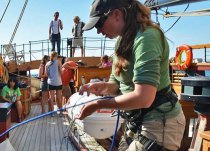The 10-R’s of Sustainability TM
Over the years we have always premised yearly themes with collective suggestions on a variety of environmental issues with global impact. This year's theme culminates in compounding issues for our very survival. In that regard, the 53rd Anniversary of Earth Month presented its theme 'Water ...Now or Never".
Over the past 50 years and beyond, many advancements have been made, but yet many people, organizations, corporations, and governments globally have forgotten the basics of what Nature is. “It is not so much what nature can do for you, it is what everyone as individuals and collectively does to protect and preserve nature as it was designed.”
As mere humans with great intellect entrusted with this prospect, we have failed miserably in doing so; primarily due to the lack of self-control or the greed of others, organizations, corporations, and governments.
It is a time to reflect and look back to see what has been missed and improve upon it. In doing so one must examine not only what real sustainability is but when and why did it come about. With this in mind, it is easier to visualize and embrace “The 10-R’s of Sustainability TM ©” with a focus on natural, physical, social, cultural, and economic environments.
Sustainability has many definitions, though it is a noun, the adjunctive form of sustainable is more appropriate at times. In short, it is the ability to sustain, “to sustain life” in itself. Sustainability is embodied as a principal, with two essential attributes or categories, primarily those being natural and physically obtainable sustainability attributes herein. Everything that we need for our survival and well-being depends, either directly or indirectly, on our natural environment.
Sustainability creates and maintains the conditions under which humans and nature can exist in productive harmony, that permit fulfilling the social, economic, and other requirements of present and future generations.
Sustainability is most commonly used in the broad sense to apply to the environment in two parts. 1.) natural and 2.) physical, and further encompasses social, cultural, and economic environs. It is readily utilized in business, industry, and government. Sustainability is important to make sure that we have and will continue to have, the water, materials, and resources to protect human health and our most precious environment. Sustainability is important in bridging the social gap between individuals, businesses, industries, medicine/health, and governments. However, it is not to be a part of the UN's Agenda 21!
The world’s population of almost 8 billion is likely to increase to 9 billion by 2050. The demand for diminishing natural resources is growing. Income gaps are widening. Sustainability calls for a decent standard of living for everyone today without compromising the needs of future generations.
This means finding better ways of doing things which include but are not limited to:
1. How can we help people move out of poverty and get good jobs while protecting the environment?
2. How can we provide access to clean energy for everyone, and make sure that the energy we produce doesn’t contribute to climate change or global warming?
3. How can we make sure that everyone can get the water, food, and nutrition they need? (1.4 billion people do not have access to potable water)
4. How can we shape our cities so that everyone can enjoy a decent quality of life?
5. How can we build better transportation systems that allow us all to get where we want to go, without causing too much congestion and pollution?
6. How can we make sure that our oceans are healthy and that marine life is not threatened by pollution and climate change?
7. How can we make sure that our communities are resilient in the face of natural disasters?
8. What is the real effect of climate change and global warming on our total ecosystem and food supplies?
These eight questions pose only a few of the hundreds of problems that need to be resolved. How many more can you pose, better yet how many can you help resolve in doing your part?
In doing so we must reflect back to when the first historical record was made of the root word or term “sustain.” This was first penned in 1513 BCE as a principle to provide the necessities of sustaining life. It was first performed in 4026 BCE. It later included principles and laws reflecting further on these points, and embracing health, sanitation, and safety codes. These same principles are utilized today around the globe and are put into regulations and laws for the sustainable protection of our very lives.
The principles embodied today are “The 10-R’s of Sustainability.” They are not needed to be memorized but as a means to reflect and move forward to the future in sustaining individual lives and our most precious environment. Even science has demonstrated that they are intelligent principles by design embodied in nature and nature’s laws by creative works. These principles expand well into sustainable best practices today and for the future in education, business, industry, medicine, health, government, etc. at a simple glance as:
RESPECT: It all starts with respect as weighty regard to first have esteem for one’s self, then others, property, our natural, physical, cultural, social, and economic environments; and our earth’s delicate ecosystem. Without this, one cannot see beyond their nose and accomplish the good needed.
REFUSE: Reject the idea of utilizing anything that may cause harm to oneself, someone else, or our delicate ecosystem. Refuse to use food items and products that are falsely represented and not certified correctly. Refuse to do what is wrong.
REDUCE: Decrease, cut, lessen, or diminish the utilization of raw or natural resources, and consumption of the same in a finished product or good, or in the transportation of products or goods including but not limited to food or such products made from chemicals or minerals.
REUSE: Reclaim or reprocess items that have been used so as not to become totally spent beyond use again.
RENEW: Repair, rebuild, and reconstruct items we have used so they can have or serve a useful purpose once again; to repurpose.
RECYCLE: Reclaim or reprocess items that have expired from their serviceable purpose, so they may once again be made into something useful, and reduce the need for raw materials and expending energy to make new products.
RESPONSIBILITY: Mental, moral, or legal accountability to individuals, businesses, and governmental actions with a view to transparency.
RETHINK: To change one’s mind thought, and figurative heart condition so they will not take the wrong course of action and cause harm to another, or to our environment; collectively business and government have to change their dismal pattern of thinking.
REPLANT: To replace vegetation on land and waterways, that has been removed for any reason, and to prevent degradation or deforestation.
RESTORE: Return damaged systems to their original or better condition than previously recorded, to ensure they can recover, mature, and grow without further hindrance or harm.
When one thinks of Earth Month, it is a month of activities, bringing about awareness and sharing of knowledge about environmental and social-economic issues in any given area or region by its intrinsic needs. A month of such activities broadens a time period with the hope that such activities will continue throughout the year. It is not a political issue! Return to Nature and utilize The 10-R’s of Sustainability TM © to the fullest.
So go out, work hard, and have fun, enjoy yourself and our wonderful environment by improving it. Along the way, you will touch others and be better for it.
Copyright 2015 by Brad Follett





